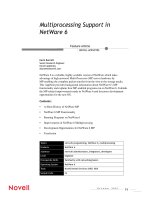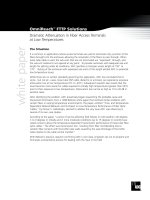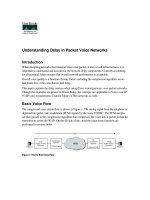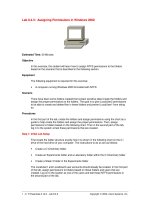Tài liệu Free As in Freedom: Richard Stallman''''s Crusade for Free Software pdf
Bạn đang xem bản rút gọn của tài liệu. Xem và tải ngay bản đầy đủ của tài liệu tại đây (886.44 KB, 413 trang )
Free As in Freedom: Richard
Stallman's Crusade for Free Software.
By Sam Williams
Available on the web at:
Produced under the Free Documentation License
Table of Contents
Chapter 1 For Want of a Printer
Chapter 2 2001: A Hacker's Odyssey
Chapter 3 A Portrait of the Hacker as a Young Man
Chapter 4 Impeach God
Chapter 5 Small Puddle of Freedom
Chapter 6 The Emacs Commune
Chapter 7 A Stark Moral Choice
Chapter 8 St. Ignucius
Chapter 9 The GNU General Public License
Chapter 10 GNU/Linux
Chapter 11 Open Source
Chapter 12 A Brief Journey Through Hacker Hell
Chapter 13 Continuing the Fight
Chapter 14 Epilogue:
Chapter 15 Appendix A : Terminology
Chapter 16 Appendix B Hack, Hackers, and Hacking
Chapter 17 Appendix C GNU Free Documentation License (GFDL)
Preface
The work of Richard M. Stallman literally speaks for
itself. From the documented source code to the
published papers to the recorded speeches, few people
have expressed as much willingness to lay their
thoughts and their work on the line.
Such openness-if one can pardon a momentary un-Stallman
adjective-is refreshing. After all, we live in a
society that treats information, especially personal
information, as a valuable commodity. The question
quickly arises. Why would anybody want to part with so
much information and yet appear to demand nothing in return?
As we shall see in later chapters, Stallman does not
part with his words or his work altruistically. Every
program, speech, and on-the-record bon mot comes with a
price, albeit not the kind of price most people are
used to paying.
I bring this up not as a warning, but as an admission.
As a person who has spent the last year digging up
facts on Stallman's personal history, it's more than a
little intimidating going up against the Stallman
oeuvre. "Never pick a fight with a man who buys his ink
by the barrel," goes the old Mark Twain adage. In the
case of Stallman, never attempt the definitive
biography of a man who trusts his every thought to the
public record.
For the readers who have decided to trust a few hours
of their time to exploring this book, I can confidently
state that there are facts and quotes in here that one
won't find in any Slashdot story or Google search.
Gaining access to these facts involves paying a price,
however. In the case of the book version, you can pay
for these facts the traditional manner, i.e., by
purchasing the book. In the case of the electronic
versions, you can pay for these facts in the free
software manner. Thanks to the folks at O'Reilly &
Associates, this book is being distributed under the
GNU Free Documentation License, meaning you can help to
improve the work or create a personalized version and
release that version under the same license.
If you are reading an electronic version and prefer to
accept the latter payment option, that is, if you want
to improve or expand this book for future readers, I
welcome your input. Starting in June, 2002, I will be
publishing a bare bones HTML version of the book on the
web site, . My aim is to update
it regularly and expand the Free as in Freedom story as
events warrant. If you choose to take the latter
course, please review Appendix C of this book. It
provides a copy of your rights under the GNU Free
Documentation License.
For those who just plan to sit back and read, online or
elsewhere, I consider your attention an equally
valuable form of payment. Don't be surprised, though,
if you, too, find yourself looking for other ways to
reward the good will that made this work possible.
One final note: this is a work of journalism, but it is
also a work of technical documentation. In the process
of writing and editing this book, the editors and I
have weighed the comments and factual input of various
participants in the story, including Richard Stallman
himself. We realize there are many technical details in
this story that may benefit from additional or refined
information. As this book is released under the GFDL,
we are accepting patches just like we would with any
free software program. Accepted changes will be posted
electronically and will eventually be incorporated into
future printed versions of this work. If you would like
to contribute to the further improvement of this book,
you can reach me at Comments and
Questions Please address comments and questions
concerning this book to the publisher: O'Reilly &
Associates, Inc. 1005 Gravenstein Highway North
Sebastopol, CA 95472 (800) 998-9938 (in the United
States or Canada) (707) 829-0515 (international/local)
(707) 829-0104 (fax) There is a web page for this book,
which lists errata, examples, or any additional
information. The site also includes a link to a forum
where you can discuss the book with the author and
other readers. You can access this site at:
To comment or
ask technical questions about this book, send email to:
For more information about
books, conferences, Resource Centers, and the O'Reilly
Network, see the O'Reilly web site at:
Acknowledgments Special thanks
to Henning Gutmann for sticking by this book. Special
thanks to Aaron Oas for suggesting the idea to Tracy in
the first place. Thanks to Laurie Petrycki, Jeffrey
Holcomb, and all the others at O'Reilly & Associates.
Thanks to Tim O'Reilly for backing this book. Thanks to
all the first-draft reviewers: Bruce Perens, Eric
Raymond, Eric Allman, Jon Orwant, Julie and Gerald Jay
Sussman, Hal Abelson, and Guy Steele. I hope you enjoy
this typo-free version. Thanks to Alice Lippman for the
interviews, cookies, and photographs. Thanks to my
family, Steve, Jane, Tish, and Dave. And finally, last
but not least: thanks to Richard Stallman for having
the guts and endurance to "show us the code."
Sam Williams
For Want of a Printer
I fear the Greeks. Even when they bring gifts.
Virgil The Aeneid
The new printer was jammed, again.
Richard M. Stallman, a staff software programmer at the
Massachusetts Institute of Technology's Artificial
Intelligence Laboratory (AI Lab), discovered the
malfunction the hard way. An hour after sending off a
50-page file to the office laser printer, Stallman, 27,
broke off a productive work session to retrieve his
documents. Upon arrival, he found only four pages in
the printer's tray. To make matters even more
frustrating, the four pages belonged to another user,
meaning that Stallman's print job and the unfinished
portion of somebody else's print job were still trapped
somewhere within the electrical plumbing of the lab's
computer network.
Waiting for machines is an occupational hazard when
you're a software programmer, so Stallman took his
frustration with a grain of salt. Still, the difference
between waiting for a machine and waiting on a machine
is a sizable one. It wasn't the first time he'd been
forced to stand over the printer, watching pages print
out one by one. As a person who spent the bulk of his
days and nights improving the efficiency of machines
and the software programs that controlled them,
Stallman felt a natural urge to open up the machine,
look at the guts, and seek out the root of the problem.
Unfortunately, Stallman's skills as a computer
programmer did not extend to the mechanical-engineering
realm. As freshly printed documents poured out of the
machine, Stallman had a chance to reflect on other ways
to circumvent the printing jam problem.
How long ago had it been that the staff members at the
AI Lab had welcomed the new printer with open arms?
Stallman wondered. The machine had been a donation from
the Xerox Corporation. A cutting edge prototype, it was
a modified version of the popular Xerox photocopier.
Only instead of making copies, it relied on software
data piped in over a computer network to turn that data
into professional-looking documents. Created by
engineers at the world-famous Xerox Palo Alto Research
Facility, it was, quite simply, an early taste of the
desktop-printing revolution that would seize the rest
of the computing industry by the end of the decade.
Driven by an instinctual urge to play with the best new
equipment, programmers at the AI Lab promptly
integrated the new machine into the lab's sophisticated
computing infrastructure. The results had been
immediately pleasing. Unlike the lab's old laser
printer, the new Xerox machine was fast. Pages came
flying out at a rate of one per second, turning a
20-minute print job into a 2-minute print job. The new
machine was also more precise. Circles came out looking
like circles, not ovals. Straight lines came out
looking like straight lines, not low-amplitude sine waves.
It was, for all intents and purposes, a gift too good
to refuse.
It wasn't until a few weeks after its arrival that the
machine's flaws began to surface. Chief among the
drawbacks was the machine's inherent susceptibility to
paper jams. Engineering-minded programmers quickly
understood the reason behind the flaw. As a
photocopier, the machine generally required the direct
oversight of a human operator. Figuring that these
human operators would always be on hand to fix a paper
jam, if it occurred, Xerox engineers had devoted their
time and energies to eliminating other pesky problems.
In engineering terms, user diligence was built into the system.
In modifying the machine for printer use, Xerox
engineers had changed the user-machine relationship in
a subtle but profound way. Instead of making the
machine subservient to an individual human operator,
they made it subservient to an entire networked
population of human operators. Instead of standing
directly over the machine, a human user on one end of
the network sent his print command through an extended
bucket-brigade of machines, expecting the desired
content to arrive at the targeted destination and in
proper form. It wasn't until he finally went to check
up on the final output that he realized how little of
the desired content had made it through.
Stallman himself had been of the first to identify the
problem and the first to suggest a remedy. Years
before, when the lab was still using its old printer,
Stallman had solved a similar problem by opening up the
software program that regulated the printer on the
lab's PDP-11 machine. Stallman couldn't eliminate paper
jams, but he could insert a software command that
ordered the PDP-11 to check the printer periodically
and report back to the PDP-10, the lab's central
computer. To ensure that one user's negligence didn't
bog down an entire line of print jobs, Stallman also
inserted a software command that instructed the PDP-10
to notify every user with a waiting print job that the
printer was jammed. The notice was simple, something
along the lines of "The printer is jammed, please fix
it," and because it went out to the people with the
most pressing need to fix the problem, chances were
higher that the problem got fixed in due time.
As fixes go, Stallman's was oblique but elegant. It
didn't fix the mechanical side of the problem, but it
did the next best thing by closing the information loop
between user and machine. Thanks to a few additional
lines of software code, AI Lab employees could
eliminate the 10 or 15 minutes wasted each week in
running back and forth to check on the printer. In
programming terms, Stallman's fix took advantage of the
amplified intelligence of the overall network.
"If you got that message, you couldn't assume somebody
else would fix it," says Stallman, recalling the logic.
"You had to go to the printer. A minute or two after
the printer got in trouble, the two or three people who
got messages arrive to fix the machine. Of those two or
three people, one of them, at least, would usually know
how to fix the problem."
Such clever fixes were a trademark of the AI Lab and
its indigenous population of programmers. Indeed, the
best programmers at the AI Lab disdained the term
programmer, preferring the more slangy occupational
title of hacker instead. The job title covered a host
of activities-everything from creative mirth making to
the improvement of existing software and computer
systems. Implicit within the title, however, was the
old-fashioned notion of Yankee ingenuity. To be a
hacker, one had to accept the philosophy that writing a
software program was only the beginning. Improving a
program was the true test of a hacker's skills.For more on the term "hacker,"
see Appendix B.
Such a philosophy was a major reason why companies like
Xerox made it a policy to donate their machines and
software programs to places where hackers typically
congregated. If hackers improved the software,
companies could borrow back the improvements,
incorporating them into update versions for the
commercial marketplace. In corporate terms, hackers
were a leveragable community asset, an auxiliary
research-and-development division available at minimal cost.
It was because of this give-and-take philosophy that
when Stallman spotted the print-jam defect in the Xerox
laser printer, he didn't panic. He simply looked for a
way to update the old fix or " hack" for the new
system. In the course of looking up the Xerox
laser-printer software, however, Stallman made a
troubling discovery. The printer didn't have any
software, at least nothing Stallman or a fellow
programmer could read. Until then, most companies had
made it a form of courtesy to publish source-code
files-readable text files that documented the
individual software commands that told a machine what
to do. Xerox, in this instance, had provided software
files in precompiled, or binary, form. Programmers were
free to open the files up if they wanted to, but unless
they were an expert in deciphering an endless stream of
ones and zeroes, the resulting text was pure gibberish.
Although Stallman knew plenty about computers, he was
not an expert in translating binary files. As a hacker,
however, he had other resources at his disposal. The
notion of information sharing was so central to the
hacker culture that Stallman knew it was only a matter
of time before some hacker in some university lab or
corporate computer room proffered a version of the
laser-printer source code with the desired source-code files.
After the first few printer jams, Stallman comforted
himself with the memory of a similar situation years
before. The lab had needed a cross-network program to
help the PDP-11 work more efficiently with the PDP-10.
The lab's hackers were more than up to the task, but
Stallman, a Harvard alumnus, recalled a similar program
written by programmers at the Harvard computer-science
department. The Harvard computer lab used the same
model computer, the PDP-10, albeit with a different
operating system. The Harvard computer lab also had a
policy requiring that all programs installed on the
PDP-10 had to come with published source-code files.
Taking advantage of his access to the Harvard computer
lab, Stallman dropped in, made a copy of the
cross-network source code, and brought it back to the
AI Lab. He then rewrote the source code to make it more
suitable for the AI Lab's operating system. With no
muss and little fuss, the AI Lab shored up a major gap
in its software infrastructure. Stallman even added a
few features not found in the original Harvard program,
making the program even more useful. "We wound up using
it for several years," Stallman says.
From the perspective of a 1970s-era programmer, the
transaction was the software equivalent of a neighbor
stopping by to borrow a power tool or a cup of sugar
from a neighbor. The only difference was that in
borrowing a copy of the software for the AI Lab,
Stallman had done nothing to deprive Harvard hackers
the use of their original program. If anything, Harvard
hackers gained in the process, because Stallman had
introduced his own additional features to the program,
features that hackers at Harvard were perfectly free to
borrow in return. Although nobody at Harvard ever came
over to borrow the program back, Stallman does recall a
programmer at the private engineering firm, Bolt,
Beranek & Newman, borrowing the program and adding a
few additional features, which Stallman eventually
reintegrated into the AI Lab's own source-code archive.
"A program would develop the way a city develops," says
Stallman, recalling the software infrastructure of the
AI Lab. "Parts would get replaced and rebuilt. New
things would get added on. But you could always look at
a certain part and say, `Hmm, by the style, I see this
part was written back in the early 60s and this part
was written in the mid-1970s.'"
Through this simple system of intellectual accretion,
hackers at the AI Lab and other places built up robust
creations. On the west coast, computer scientists at UC
Berkeley, working in cooperation with a few low-level
engineers at AT&T, had built up an entire operating
system using this system. Dubbed Unix, a play on an
older, more academically respectable operating system
called Multics, the software system was available to
any programmer willing to pay for the cost of copying
the program onto a new magnetic tape and shipping it.
Not every programmer participating in this culture
described himself as a hacker, but most shared the
sentiments of Richard M. Stallman. If a program or
software fix was good enough to solve your problems, it
was good enough to solve somebody else's problems. Why
not share it out of a simple desire for good karma?
The fact that Xerox had been unwilling to share its
source-code files seemed a minor annoyance at first. In
tracking down a copy of the source-code files, Stallman
says he didn't even bother contacting Xerox. "They had
already given us the laser printer," Stallman says.
"Why should I bug them for more?"
When the desired files failed to surface, however,
Stallman began to grow suspicious. The year before,
Stallman had experienced a blow up with a doctoral
student at Carnegie Mellon University. The student,
Brian Reid, was the author of a useful text-formatting
program dubbed Scribe. One of the first programs that
gave a user the power to define fonts and type styles
when sending a document over a computer network, the
program was an early harbinger of HTML, the lingua
franca of the World Wide Web. In 1979, Reid made the
decision to sell Scribe to a Pittsburgh-area software
company called Unilogic. His graduate-student career
ending, Reid says he simply was looking for a way to
unload the program on a set of developers that would
take pains to keep it from slipping into the public
domain. To sweeten the deal, Reid also agreed to insert
a set of time-dependent functions- "time bombs" in
software-programmer parlance-that deactivated freely
copied versions of the program after a 90-day
expiration date. To avoid deactivation, users paid the
software company, which then issued a code that defused
the internal time-bomb feature.
For Reid, the deal was a win-win. Scribe didn't fall
into the public domain, and Unilogic recouped on its
investment. For Stallman, it was a betrayal of the
programmer ethos, pure and simple. Instead of honoring
the notion of share-and-share alike, Reid had inserted
a way for companies to compel programmers to pay for
information access.
As the weeks passed and his attempts to track down
Xerox laser-printer source code hit a brick wall,
Stallman began to sense a similar money-for-code
scenario at work. Before Stallman could do or say
anything about it, however, good news finally trickled
in via the programmer grapevine. Word had it that a
scientist at the computer-science department at
Carnegie Mellon University had just departed a job at
the Xerox Palo Alto Research Center. Not only had the
scientist worked on the laser printer in question, but
according to rumor, he was still working on it as part
of his research duties at Carnegie Mellon.
Casting aside his initial suspicion, Stallman made a
firm resolution to seek out the person in question
during his next visit to the Carnegie Mellon campus.
He didn't have to wait long. Carnegie Mellon also had a
lab specializing in artificial-intelligence research,
and within a few months, Stallman had a
business-related reason to visit the Carnegie Mellon
campus. During that visit, he made sure to stop by the
computer-science department. Department employees
directed him to the office of the faculty member
leading the Xerox project. When Stallman reached the
office, he found the professor working there.
In true engineer-to-engineer fashion, the conversation
was cordial but blunt. After briefly introducing
himself as a visitor from MIT, Stallman requested a
copy of the laser-printer source code so that he could
port it to the PDP-11. To his surprise, the professor
refused to grant his request.
"He told me that he had promised not to give me a
copy," Stallman says.
Memory is a funny thing. Twenty years after the fact,
Stallman's mental history tape is notoriously blank in
places. Not only does he not remember the motivating
reason for the trip or even the time of year during
which he took it, he also has no recollection of the
professor or doctoral student on the other end of the
conversation. According to Reid, the person most likely
to have fielded Stallman's request is Robert Sproull, a
former Xerox PARC researcher and current director of
Sun Laboratories, a research division of the
computer-technology conglomerate Sun Microsystems.
During the 1970s, Sproull had been the primary
developer of the laser-printer software in question
while at Xerox PARC. Around 1980, Sproull took a
faculty research position at Carnegie Mellon where he
continued his laser-printer work amid other projects.
"The code that Stallman was asking for was leading-edge
state-of-the-art code that Sproull had written in the
year or so before going to Carnegie Mellon," recalls
Reid. "I suspect that Sproull had been at Carnegie
Mellon less than a month before this request came in."
When asked directly about the request, however, Sproull
draws a blank. "I can't make a factual comment," writes
Sproull via email. "I have absolutely no recollection
of the incident."
With both participants in the brief conversation
struggling to recall key details-including whether the
conversation even took place-it's hard to gauge the
bluntness of Sproull's refusal, at least as recalled by
Stallman. In talking to audiences, Stallman has made
repeated reference to the incident, noting that
Sproull's unwillingness to hand over the source code
stemmed from a nondisclosure agreement, a contractual
agreement between Sproull and the Xerox Corporation
giving Sproull, or any other signatory, access the
software source code in exchange for a promise of
secrecy. Now a standard item of business in the
software industry, the nondisclosure agreement, or NDA,
was a novel development at the time, a reflection of
both the commercial value of the laser printer to Xerox
and the information needed to run it. "Xerox was at the
time trying to make a commercial product out of the
laser printer," recalls Reid. "They would have been
insane to give away the source code."
For Stallman, however, the NDA was something else
entirely. It was a refusal on the part of Xerox and
Sproull, or whomever the person was that turned down
his source-code request that day, to participate in a
system that, until then, had encouraged software
programmers to regard programs as communal resources.
Like a peasant whose centuries-old irrigation ditch had
grown suddenly dry, Stallman had followed the ditch to
its source only to find a brand-spanking-new
hydroelectric dam bearing the Xerox logo.
For Stallman, the realization that Xerox had compelled
a fellow programmer to participate in this newfangled
system of compelled secrecy took a while to sink in. At
first, all he could focus on was the personal nature of
the refusal. As a person who felt awkward and out of
sync in most face-to-face encounters, Stallman's
attempt to drop in on a fellow programmer unannounced
had been intended as a demonstration of neighborliness.
Now that the request had been refused, it felt like a
major blunder. "I was so angry I couldn't think of a
way to express it. So I just turned away and walked out
without another word," Stallman recalls. "I might have
slammed the door. Who knows? All I remember is wanting
to get out of there."
Twenty years after the fact, the anger still lingers,
so much so that Stallman has elevated the event into a
major turning point. Within the next few months, a
series of events would befall both Stallman and the AI
Lab hacker community that would make 30 seconds worth
of tension in a remote Carnegie Mellon office seem
trivial by comparison. Nevertheless, when it comes time
to sort out the events that would transform Stallman
from a lone hacker, instinctively suspicious of
centralized authority, to a crusading activist applying
traditional notions of liberty, equality, and
fraternity to the world of software development,
Stallman singles out the Carnegie Mellon encounter for
special attention.
"It encouraged me to think about something that I'd
already been thinking about," says Stallman. "I already
had an idea that software should be shared, but I
wasn't sure how to think about that. My thoughts
weren't clear and organized to the point where I could
express them in a concise fashion to the rest of the world."
Although previous events had raised Stallman's ire, he
says it wasn't until his Carnegie Mellon encounter that
he realized the events were beginning to intrude on a
culture he had long considered sacrosanct. As an elite
programmer at one of the world's elite institutions,
Stallman had been perfectly willing to ignore the
compromises and bargains of his fellow programmers just
so long as they didn't interfere with his own work.
Until the arrival of the Xerox laser printer, Stallman
had been content to look down on the machines and
programs other computer users grimly tolerated. On the
rare occasion that such a program breached the AI Lab's
walls-when the lab replaced its venerable Incompatible
Time Sharing operating system with a commercial
variant, the TOPS 20, for example-Stallman and his
hacker colleagues had been free to rewrite, reshape,
and rename the software according to personal taste.
Now that the laser printer had insinuated itself within
the AI Lab's network, however, something had changed.
The machine worked fine, barring the occasional paper
jam, but the ability to modify according to personal
taste had disappeared. From the viewpoint of the entire
software industry, the printer was a wake-up call.
Software had become such a valuable asset that
companies no longer felt the need to publicize source
code, especially when publication meant giving
potential competitors a chance to duplicate something
cheaply. From Stallman's viewpoint, the printer was a
Trojan Horse. After a decade of failure, privately
owned software-future hackers would use the term "
proprietary" software-had gained a foothold inside the
AI Lab through the sneakiest of methods. It had come
disguised as a gift.
That Xerox had offered some programmers access to
additional gifts in exchange for secrecy was also
galling, but Stallman takes pains to note that, if
presented with such a quid pro quo bargain at a younger
age, he just might have taken the Xerox Corporation up
on its offer. The awkwardness of the Carnegie Mellon
encounter, however, had a firming effect on Stallman's
own moral lassitude. Not only did it give him the
necessary anger to view all future entreaties with
suspicion, it also forced him to ask the uncomfortable









